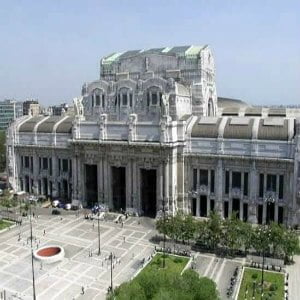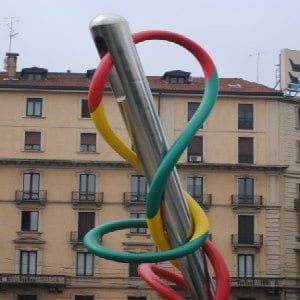I’m not exaggerating considering Milan metro as a service of excellence on the Milan city transportation network. Most cities in Italy don’t have metro systems but only few (Rome isn’t one of them) can be proud of so efficient way to get around a city, like Milan.
I love Milan subway systems, not only because it’s the cheapest and the fastest way to get around a city but definitely the only way to get from one sightseeing point to another. It’s the popular means of public transportation in Milan used by the majority of locals but also more and more by Milan city visitors.
Network Overview
Milan subway network with its four lines (with fifth under construction) can be rather intimidating and quite unfamiliar particularly if you aren’t used to riding underground. Although Milan’s city network covers almost all parts of the city, sometimes it’s necessary to use the combination of transportation means, like a tram or bus.
In order to help to understand how to use it, let’s see how Milan’s underground works and what it consists of. Officially metro system is covered by four lines fully functional while the fifth (called blue line is under construction). It’s 96,9 km long with average daily 1.500.000 passengers.
Underground Network
Below are four underground lines indicated by numbers and corresponding colors (red, green, yellow and lilac). Each of these lines will be represented by maps including those found in Milan metro maps.
To addition to four metro lines, Milan has a railway loop (in Italian ‘passante ferroviario‘) that is an almost entirely underground system (called Lines S) that crosses Milan with 5 lines called “suburban lines” connecting the hinterland area of Milan and the city center. Actually there are 13 S lines
M1 Line

M1, called redM is one of the most important metro lines that covers the principal city tourist highlights.
It’s the oldest line built in 1964. It’s 27 km long that connects the city from north-east to west. It is divided into two branches from Sesto 1° Maggio to Rho Fiera (Fair Ground) and to Bisceglie with two urban limits sections.
M2 Line

M2, called green is the longest line inside the metro system. It was built in 1969. It’s 39,4 km long. This line has two branches on both sides of the line.
These are Abbiategrasso and Assago Milanofiori Forum on the south and Gessate and Cologno Nord. As line M1 this one also has urban limits sections.
M3 Line

M3, called yellow is one of the newest metro lines whose construction was inaugurated in 1990 and finished in 2011.
It’s only 17 km long. It’s a semi-automatic line as the driver controls only the opening or closing of the doors and the departure of the train. This line connects two important city points, Stazione Centrale and Piazza Duomo.
M4 Line

M4, will be called the Blue Line.
It’s a new metro line under construction and it will connect the city from the east, with terminal at Linate Airport (in the municipality of Segrate) to the south-west, with terminal at San Cristoforo (in the municipality of Milan). Inauguration is planned for January 2023 and it will be 16 km long.
M5 Line

M5, called lilac is a new new Milan metro line characterized by the lilac color, almost completely automated.
It’s 16 km long and it was inaugurated in 2015. Connects the northern part of the city with 19 station from Bignami street all the way to famous football stadium San Siro, the temple of Milan and Inter clubs.
Metro Stations
With four active metro lines and numerous stations, it’s almost impossible for first time visitors to guess where to find a right metro station near to their hotel or which line goes to their favorite destinations. Here are essential things you should do first:
- The first thing you should do is to find your accommodation in Milan inside the Milan metro network area.
- Your second task will be, using the metro map, to establish your undergrounds destination that are near to your city sight you are planning to visit.
- Keep in mind that some stops have more than one Metro line, but this will make easier to reach your destination from different parts of the city.
- To discover and find the Milan city transport route, visit the Giromilano, a simple application to easily find the location, the fastest route and discover the route with the various alternatives of public transport including metro.
For first time visitors here are the most important metro stations:
Duomo Station

There is an old saying, ‘all roads lead to the Duomo’. This is the only place that every visitors will be visiting.
Only few metro station names are the same as the attraction you want to see. Duomo is the only one.
There are two lines that lead to Duomo Cathedral, M1 (red) and M3 (yellow). If you are looking for accommodation near Duomo metro station, here are some hotels close to Piazza Duomo.
Centrale Station

Stazione Centrale (Main Milan Railway station) is another Metro station, served by Red (M1) and Yellow (M3) lines.
If you reach Milan by train or by schedule bus from Malpensa or Linate airports, this metro stop will be probably your first Milan underground experience.
Near this metro station you can find many accommodation offers from low budget hotels to luxury ones.
Cadorna Station

Cadorna metro station is one of the most important Metro junctions reachable by Green and Red lines.
If you decide to visit Castello Sforzesco (Fortress) you can take Red (M1) or Green (M2) line. Cadorna Metro is also important to reach Como Lake and Malpensa Airport by Malpensa Express trains to Terminal 1 and 2.
Staying in one of hotels near this metro station, you can easily reach important city sights and city districts like Brera. From here Duomo is only two metro (M1) stations away.
Most good tour guidebooks will include this information, but a city map that includes Metro stops will also be a good resource to figure this out.
Among other station, there are few that deserve to be mentioned according to the activities you have in mind, , for example:
- If you want to spend a romantic evening in Brera, called Milan Montmartre district, visiting La Pinacoteca di Brera art gallery, that try to remember M2 (green) Lanza – Brera (the first station after Cadorna) where you can stay in some romantic hotels.
- Another district you shouldn’t miss is Navigli Milan canal area, the best place for night stroll, searching for the best aperitif bars and top nightlife venue. To reach it, take off at Porta Genova metro station (M2 green). This area offers some excellent hotel deals around Porta Genova station.
- Are you a shopping fan? Looking for great Milan fashion brands? If so, you should take a ride on M3 (yellow line). From Duomo (one stop) take off at Montenapoleone yellow metro station and start you shopping experience at The Quadrilatero della moda ( The Quadrilateral of fashion). Hotels there will not let you down.
- Coming in Milan for business? If you have to be at Milan Fair Ground that take M1 (red line). Be careful to take the M1 branch directed to RHO Fieramilano (last stop). There’s a lot of hotels in this area.
- Are are a fan of one of the Milan’s football clubs, Milan or Inter. You are looking for a football mach? This venue is also a great place for concerts. You can easily reach San Siro stadium by new M5 (lilac) metro taking off at last stop – San Siro Stadio. You can even stay in many nearby hotels.
- The last stop on M2 (green) Assago Milanofiori Forum is another important venue for concerts, festivals (Latino American) and basket ball games. Find your accommodation nearby.
The most important is to have a good Milan metro map. You can buy one folding pocket size travel map online that beside city center street map of Milan, has an integrated Milan metro map including lines and stations.
Usage Tips
Whenever you decide to move around the city using Milan metro, an extended transportation service, I’d like to indicate some useful tips not to get lost in the various stations and reach your destination.
The first thing you have to have to, is to buy your metro ticket. You’ll find here all about how and where to buy one but also all types of tickets and how to validate your ticket.
Once you enter the metro station and after you validate your ticket, try to remember the name of the station you’ve entered. Each station has two lines, most of them are on the lower level of the station you are traveling from.
Before going down to the metro lines, check which one takes you in your chosen direction. Usually you will find the map located on both entrances to the lanes. Let’s see an example of Milan metro:
- Suppose you have just arrived by train at the Milan Central Train Station and you would like to go to Piazza Duomo, for an hour or two.
- From Central Station you have to take M3 (yellow line) as it’s the only one directed to Duomo. After you validate your ticket passing the turnstiles, check which metro line will take you to Duomo. On the wall you’ll see the map with the station you are on (Stazione Centrale). Find the Duomo station on the map and all station before it. (in this case you have three station (Repubblica, Turati and Montenapoleone)
- Next step will be to take the right line. In your case is San Donato direction. Don’t take the one directed to Comasina (it’s opposite direction). Once you step in the metro carriage, just follow the voice that will indicate (in Italian and in English) you each next metro station and the one you are directed to (Duomo).
- In case you make a mistake and you hear the name e.g Sondrio, instead Repubblica, it means you are riding in wrong direction. Don’t panic, just get off on the next stop and go to the opposite lane. Don’t worry, you don’t need a new ticket as you are already inside the metro area. See the map below!

Attention: from February 15th 2016, in all the Milan metro lines, the validation of the ticket is compulsory both in and out of the turnstiles (entrance and exit). So another good reason not to lose your ticket and keep it for the exit.
